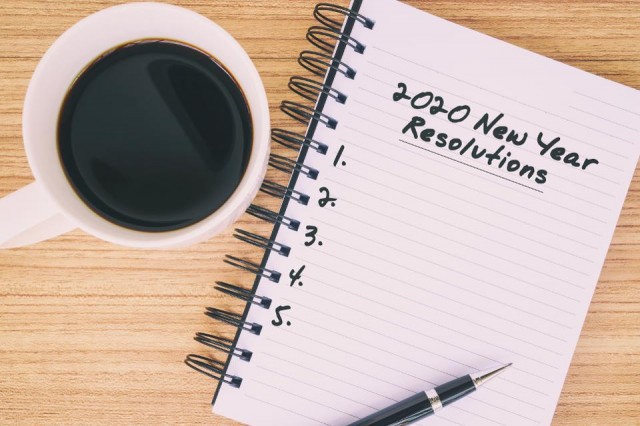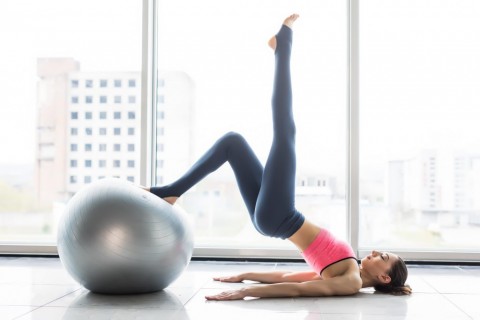New Year's Resolutions: Exercise and Nutrition Tips
- New Year's Resolutions: Exercise and Nutrition Tips
- Every Body Benefits From Pilates
For many people, exercise and nutrition are common "new year's resolution" topics. People full of good intentions, flood into the gym to get started on new, healthier lifestyles, but some of these "resolutioners" lose sight of their good intentions and fall back into old, unhealthy patterns.
If a healthier 2020 is what you want, keep that desire strong throughout the year. New habits are not born overnight; you have to keep working at them. These are some top tips for a healthy new year.
Exercise- Do what you like. There is a principle in exercise science called FITTE. It is an acronym for frequency, intensity, time, type, and enjoyment. I find the 'E' to often be the most important variable.If you look forward to (or at least do not actively hate) a particular physical activity, do it. If you like tennis, find an indoor court. If you like dancing, look into dance-based workouts like Zumba. Do whatever will make you move. Just because you know things like running and jumping are great cardio does not mean they have to be your thing.If you like what you are doing, you will do it continually. If you do not like what you are doing, you won't do it. If you are not sure what you would enjoy, try a variety of activities until you find one that sticks.
- Formulate achievable goals and milestones. Instead of formulating your ultimate goal as what you are working toward, break your goal down into achievable milestones. If you want to lose some kilos, think of it as a goal of losing 2.5kgs a month for six months. If you want to add muscle mass, you can aim for putting on 500g of muscle a month. If you want to run a 5Km run, try intervals of walking and jogging to get to the first km, then the second, then the third. Keep in mind that your goals may shift as you work toward them.
- Share your goals with the people in your life. Share what you are doing with the people around you. Having the support of others can both inspire you and hold you accountable. You will not want to report to your mother, child, or coworkers that you have given up on your goals. You will want to report that you are working hard to get what you want. You never know who will inspire you during this process. You may even inspire others to join you on your journey.
- Something is always better than nothing. I hear the question all the time, "if I can only get to the gym for half an hour, is it worth it?" The answer is always a resounding, "Yes! It is worth it!" You can get a lot done in half an hour and it keeps you in the habit of exercising.
- It's okay to be nervous, but don't let it stop you. People are often afraid to try something new. This is completely normal. Nerves can often be beaten with some extra preparation.
- If there is a group exercise class you have been curious about, but haven't gone because you are nervous about it, ask someone for more information. By finding out more about a teacher's style and the format of the class, you will feel more mentally prepared and in control.
- If you would like to try Spinning, ask someone at the gym the proper way to set up the bike and how to use the brake. That way, you will know what to do when you get into the class.
- Take small steps. Your body has all sorts of built-in alarm systems.
- Ask for help. Many types of exercise are not intuitive. While your body knows how to walk without you having to think about it, it does not automatically know how to properly lift weights or use kettlebells. If you are a member of a gym, ask a personal trainer to show you some moves. If you are not a member of a gym, look up videos of different exercises on the Internet.
- Combine lean protein, complex carbohydrates, and good fats when you eat. Separately, these are food groups that your body needs. Together, these food groups are powerhouses. Research shows that when eaten together, they will help you feel fuller for longer periods of time. The sum of these three factors is greater than its parts. Try eating an apple and some almonds as a snack and see how it makes you feel.
- Keep a food journal. Before you can figure out how to amend your food intake patterns, you have to assess where you are starting from. By writing down everything you eat and how much you eat of it, you can start to look for patterns in your consumption. Maybe you get overly hungry, then end up eating too much. Maybe you are a mindless snacker. Write down everything you eat for a week and review the information. Look up the caloric value of the foods you have been eating. The numbers may surprise you.Once you assess your food choices, there are small changes you can make that will add up to a big difference.Sugar-free pudding, sugar-free fudge pops, pickles, and wasabi peas are sweet, salty, and spicy foods you can eat without guilt. The sugar-free pudding and frozen fudge pops will satisfy your cravings for sweets; pickles will calm the salty cravings; and wasabi peas will give you some spicy bite. Wasabi peas are around 140 calories per serving, but you will find that one serving is plenty.
- Think before you eat – why are you eating?
Are you really hungry or are you eating because it is "dinner time" or you are bored?
Every Body Benefits From Pilates
Possibly one of the most exciting aspects of Pilates is that anyone can do it, and everyone can achieve amazing results. Because there's no bouncing, jarring, or stress to your body, Pilates offers the ideal form of exercise for people who, because of joint pain or muscle weakness, shy away from exercise.
It's also convenient. You don't need any heavy, expensive equipment, and you can do Pilates anywhere, anytime. Some of the routines take less than 10 minutes, making Pilates the perfect form of exercise for anyone who finds there's not enough time in the day for exercise. You have 10 minutes to strengthen your abs and back, don't you? You'll start to see and feel results in as few as 10 sessions.
Just some of the many ways you can benefit from doing Pilates regularly include:
A Healthy, Supple Spine
Pilates gives more support to your spine, creating space between each vertebra. That extra space not only makes you appear taller, it also creates more mobility, transforming your spine from a stiff rod into a supple string of pearls. This new suppleness prevents degenerative spinal problems, such as slipped disks. It also helps you move with more grace and ease.
Kinder, Gentler Conditioning
If you're out of shape, Pilates provides a wonderful way to ease into any kind of fitness plan. Pilates puts no stress on your joints and no wear and tear on your ligaments and cartilage around your joints, especially your knee and shoulder joints. It conditions your muscles in a balanced way and increases your self-awareness by drawing your focus inward. In reality, Pilates is very rehabilitative. It's almost like going to physical therapy sessions. In fact, unlike other forms of exercise, you can safely do Pilates every day without overstressing your muscles or joints. To see results, however, you need to do Pilates only three times a week. But you have to be consistent. That's the key.
Improved Mental Outlook and Increased Motivation
Pilates benefits your emotional health. The smooth, steady movements quiet your mind and soothe your nervous system. As you lengthen and strengthen your muscles, you'll improve your circulation and whisk tension away. Each workout will leave you feeling calm, balanced, and rejuvenated. Focus on letting the tension go, and you'll be on the path to a healthier body inside and out.
Better Balance, More Coordination
In your 40s, balance starts to deteriorate as your muscles weaken and your nerve receptors lose sensitivity. Pilates reverses this aging process by stabilizing your core. Pilates works the small, deep muscles needed to keep your body steady when walking and your spine both supple and strong.
Less Pain and Stiffness
If you suffer from osteoarthritis pain, you'll find that lengthening your body through Pilates will help soothe the soreness. Appropriate exercise is vital to managing arthritis, because it increases flexibility for stretches and reduces pain and fatigue. Stretching helps pump vital nutrients to your muscles and tendons, which help keep them healthy and minimize your risk of injury. It also stimulates the production of joint lubricants (synovial fluid) and prevents adhesions. As circulation increases, your legs, back, neck, and shoulders loosen up, relieving aches and stiffness. Pilates also leads to subtle posture improvements, which will also eliminate tension, driving away headaches, backaches, neck aches, and other aches and pains.
Quote of the Month - "Though no one can go back and make a brand new start, anyone can start from now and make a brand new ending."
by Carl Bard



